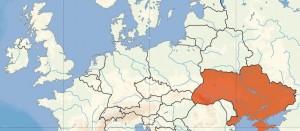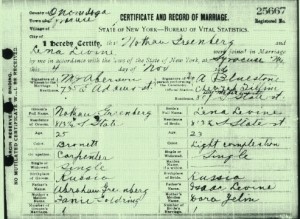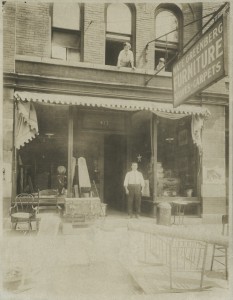Nathan’s Story
This is a work in progress. My husband’s grandfather, Nathan is a man of mystery in a family of many mysteries. I have more questions than answers, but here is what I know so far.
Nathan was born June 3, 1882 to Abraham (Alter) Greenberg and Fannie (Feige) Goldring. There were never any stories about brothers or sisters so he may have been an only child. Then again, there were very few stories about his life and even fewer about his family. It seems more likely that he had siblings but for his own reasons just never talked about his family. He was born in the shetl of Aleksandriya, Rovno province, in Russia. Rovno was also the nearest large town or city. As I have written in an early post, he said that he was apprenticed at a young age (about 7-8 years old which would have been about 1889 or 1890) to a cruel master. It could be that he either lost touch with his family when he moved, or that he was angry enough at them that he never wanted further contact. It seems likely that he was apprenticed to a cabinetmaker since that is what Nathan worked at as a young adult. At some point, Nathan ran away from this apprenticeship and made his way to London.

It is approximately 1140 miles from his birthplace to London. He never told anyone where he was living when he fled to London or how old he was at the time. An estimate would be that he was between 16-18 years old at the time, which would have been between 1898 and 1900. [Update: Cousin Jean says that the only story she heard was that Nathan said he walked out of Russia when he was 15.] I can only imagine that it must have been a long and hazardous journey for a runaway youngster. He probably didn’t have much (if any) money, so it may have taken a very long time for him to get to London. And it isn’t clear whether that was his original destination or it was happenstance that he ended up there. There would have been trains and animal-drawn vehicles, but cars were not yet common, and without money he may have had to walk or hitch rides when he could.
In later years, Nathan told his son that he had lived in the Whitechapel area of London, which was a Jewish area, and worked as a cabinetmaker. It was while in London that he met Choneh (Harry) Levine, who was also a cabinetmaker. Both young men were politically radical and probably active, at least to the extent of belonging to groups or attending speeches and rallies.
Nathan and Harry became very good friend over time. Harry persuaded Nathan that he should plan to go to America with him and meet his sister Lena. Harry thought the two of them would be a good match. Since we know that Lena was politically radical later in life, it is likely that she also was as a young woman. This may have been the reason Harry thought that they’d be a good couple. For non-religious Jews, in particular, politics and political groups were often a source of friendships and a community. At any rate, Nathan did sail to New York, on the SS Pennsylvania from Boulogne on June 5 1904. He arrived in New York on June 16th.

On the passenger list Nathan was said to have last resided in Liverpool, to have paid his own passage, and to have $10. He could not read or write, and his occupation was given as cabinetmaker. His last name was spelled Grinberg (rather than the Greenberg used the rest of his life in the US). It is difficult to decipher his intended final destination; one in Montreal seems to have been erased and another in New York written more clearly. It may be that the person named as his contact was actually Harry’s brother Sam.
Sometime in late 1905 or early 1906, Harry and his family, and Nathan, and probably Sam and his family all moved to Syracuse in upstate New York. Lena was either already there or went with them (I haven’t yet found out when she came to America). How and when Nathan and Lena met is unknown. Meet they did, however, and on November 4, 1906 they married in Syracuse.

They lived in a number of places around Syracuse over the next 15 years or so.
In 1907 Nathan filed a Declaration of Intent to naturalize. In 1907, too, Nathan and Lena’s first child, my father-in-law, was born. In 1910 the family appeared on the federal population census living on South State Street in Syracuse and a city directory shows that Nathan had a furniture store at the same address. Presumably the family lived in an apartment above the store.

In 1912 their second child, a daughter, was born. And in 1914 Nathan’s Petition for Naturalization was finalized and he and Lena became naturalized citizens. So far I have not found any World War I registration for Nathan. The family continued to live in Syracuse through 1920 (federal population census). At that point they were living in a multi-family house with Lena’s brother Sam and his family. Another of Lena’s cousin’s family lived in a little house in the backyard.
In about 1924 Nathan moved the family to Buffalo for an unknown reason. Based on my father-in-law’s memory, it was his senior year in high school and after the school year had started. According to the 1930 federal population census, as well as a city directory listing, Nathan worked (at least briefly) as an auctioneer for the Empire Outfitting company in Buffalo. This is a little confusing, since he had always worked as a cabinetmaker, carpenter, and furniture store owner, but I don’t yet know what kind of outfitting this company was selling.
The next mysterious fact about Nathan is that he applied for a Social Security number in 1940, giving a Syracuse address and employer, although the family was still living in Buffalo. Possibly he had found a job in Syracuse when he couldn’t find one in Buffalo. By this time he was 58 years old, and it is not clear how much longer he worked or at what kind of jobs.
His wife Lena died in 1959. It is not clear where Nathan was at this time. My father-in-law told a story about going to a Jewish undertaker and asked about having his mother buried in the Workmen’s Circle Cemetery, and having one of the Arbeiter Ring men speak at her funeral. Why Nathan didn’t handle this is unclear, but he may thought that my father-in-law, who was a lawyer would be better able to take care of the formalities. Shortly after Lena died Nathan moved to Rochester to live with his daughter and her family, and he lived the rest of his life there. Nathan died in 1964 and his ashes were buried under a forsythia bush in the yard at the family home.

Thank you!
You are the recipient of the Ancestor Approved Award!